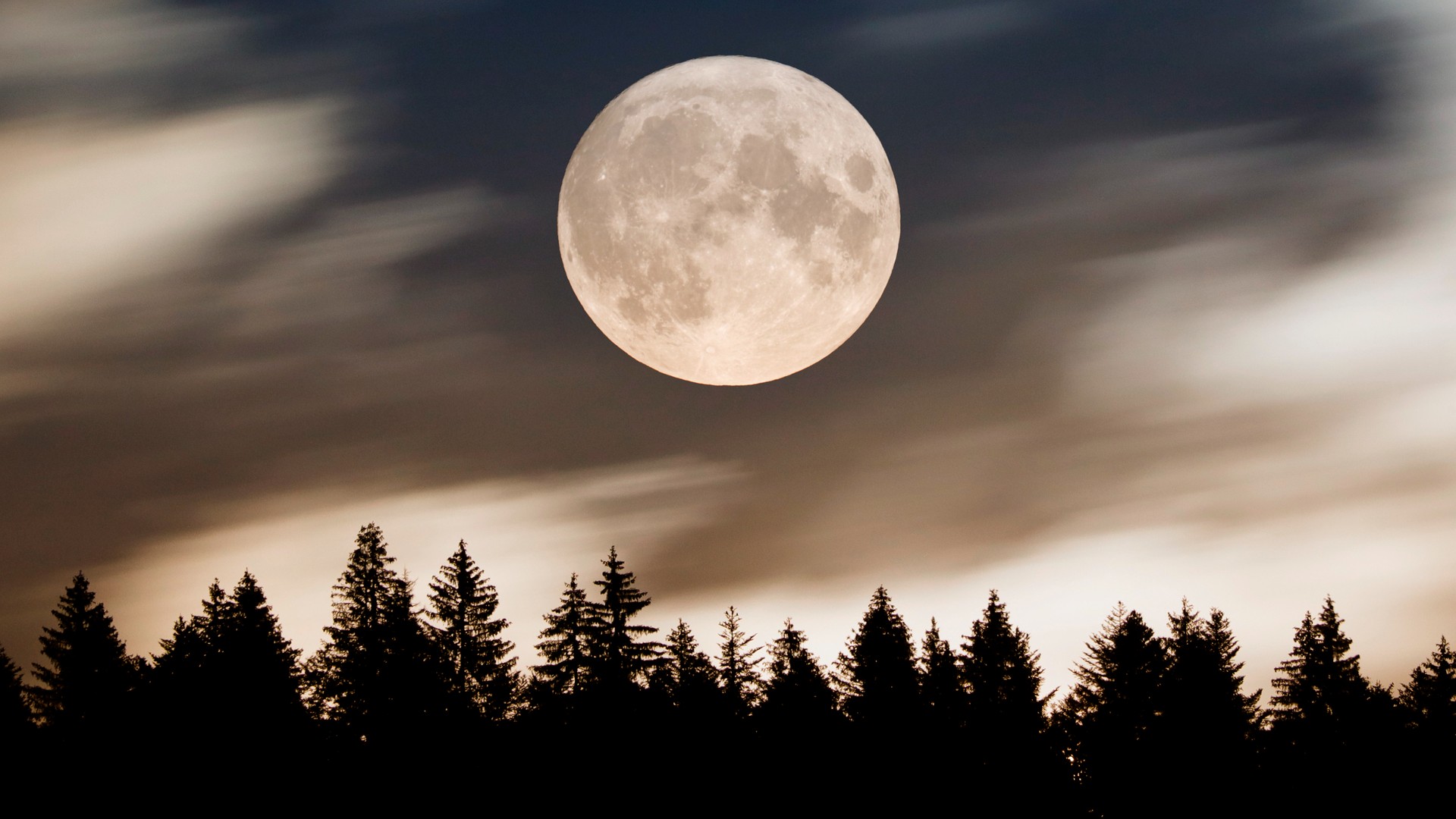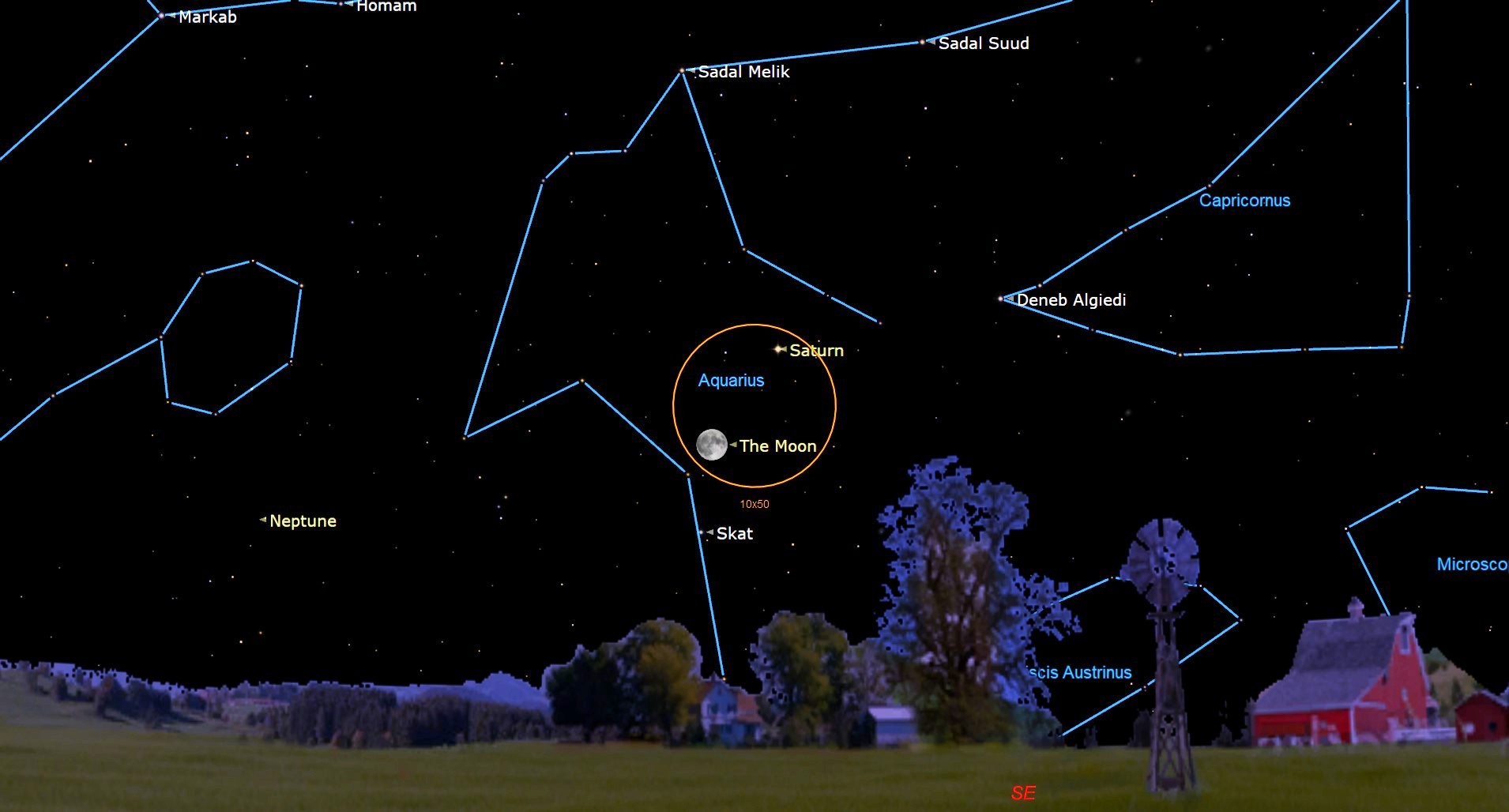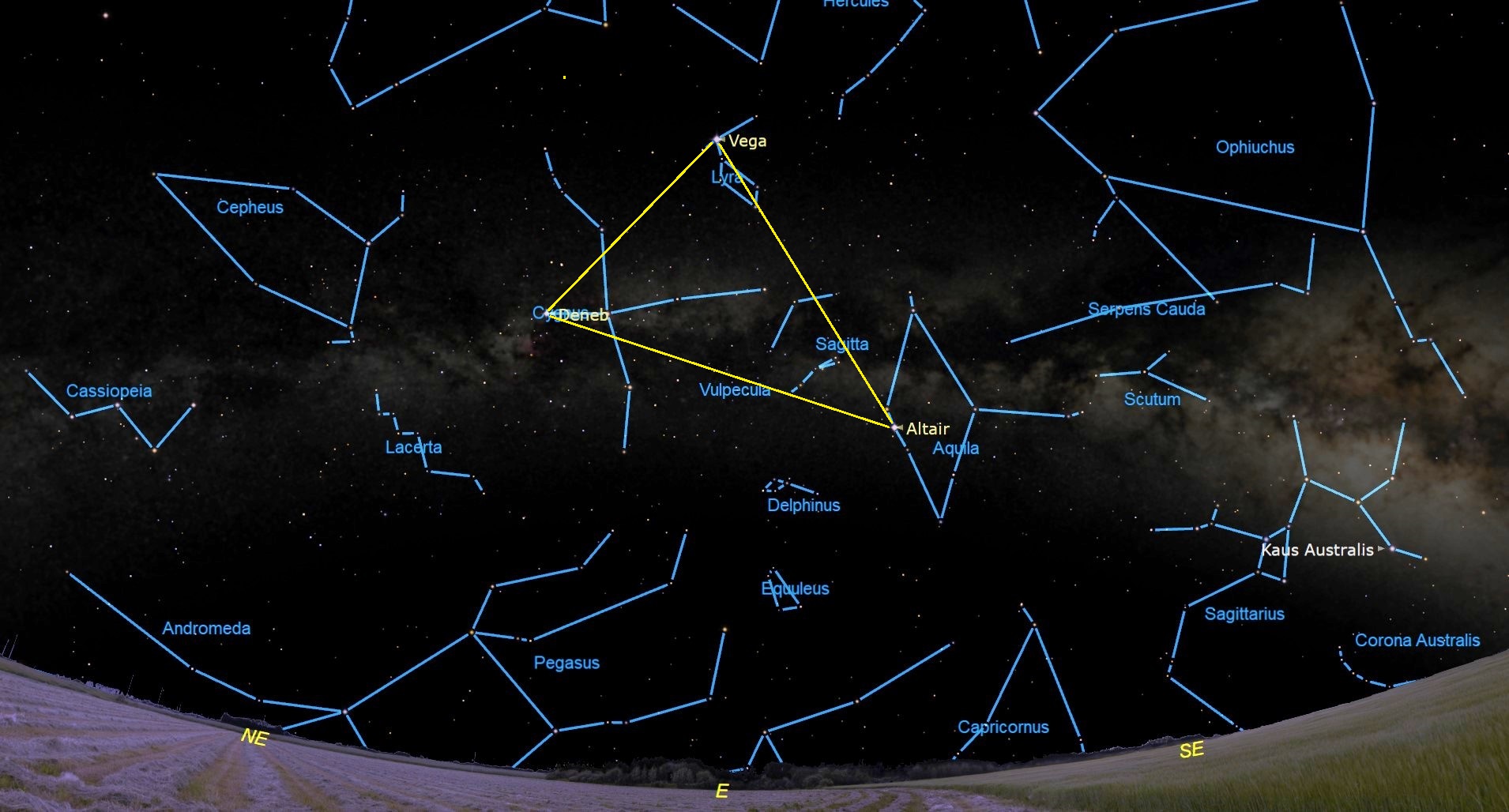August Super Blue Moon guide 2023: The biggest and brightest moon of the year snuggles up to Saturn
The Blue Moon rises on Aug. 30.

Moonwatchers get an extra treat this month with a Blue Moon.
A Blue Moon is typically defined as the third full moon in a season that has four full moons, although the term is sometimes also used to refer to a second full moon in a single month.
The Blue Moon will rise on the night of Aug. 30, at 9:35 p.m. Eastern Daylight Time, according to the U.S. Naval Observatory, and will both a "Blue Moon" and a "supermoon" – not only is it the second full moon in a month, but the moon is as close to Earth as it gets and thus appears slightly larger and brighter than normal. On the same day the moon will make a close approach the planet Saturn.
Related: Blue Moon: What is it and when is the next one?

Want to see the features of the moon up close? We recommend the Celestron Astro Fi 102 as the top pick in our best beginner's telescope guide.
Blue Moons occur about every two and a half years. "Blue moon," like "supermoon" is not really an astronomical term. A Blue Moon refers to one of two things: A second Blue Moon in a month (called a calendrical Blue Moon) or a fourth full moon in a season (a seasonal Blue Moon). A season is the period between solstices and equinoxes (so for example the Summer season starts on June 21 – the summer solstice -- and ends on Sept. 23, the autumn equinox). Ordinarily one would expect three full moons in a season, but occasionally we see four. In this case there are still three full moons between June 21 and Sept. 23, but we get two full moons in August because the month has 31 days. So this August Blue Moon is a calendrical one, not a seasonal one.
A full moon occurs when the moon is on the opposite side of the Earth from the sun, a position it reaches about every 29.5 days. Technically, its celestial longitude is 180 degrees away from the sun in the sky. The moon's orbit is tilted some five degrees from the plane of the Earth's orbit, so even though the moon is "behind" Earth, it isn't in Earth's shadow each time it makes a circuit of our planet. When it does pass through the shadow of Earth, we see a lunar eclipse, but that won't happen this time. Timing of lunar phases depends on one's time zone, because it depends on the moon's position relative to the Earth rather than one's position on Earth.
Supermoons, meanwhile, refer to when a full moon coincides with perigee, the point in the moon's orbit when it is closest to Earth. At those times the moon appears slightly larger and thus brighter, though it usually isn't noticeable to the casual observer. This happens because the orbit of the moon isn't a perfect circle; while the average distance to the moon is 238,855 miles (384,400 kilometers) this time the moon will be 221,942 miles (357,181 kilometers) away. We call this a supermoon, but in reality the moon can be that close at any time – it's just more notable when it coincides with the full phase. The moon will reach perigee at 11:55 a.m. Eastern Daylight Time, according to NASA, and appear about 7 percent larger than normal.
Breaking space news, the latest updates on rocket launches, skywatching events and more!
In New York City, the moon, in the constellation Aquarius, rises the evening of Aug. 30 at 7:44 p.m. and sets the next morning at 6:47 a.m. Saturn will appear above and to the right of the moon as it rises. The closest approach between the moon and Saturn will occur at 2:07 p.m. Eastern according to In-the-Sky-org, so it won't be visible from the Western Hemisphere. Observers in central Europe, however, are well placed to catch the moment when the moon and Saturn are in conjunction – sharing the same celestial longitude – and when they make their close approach. In Warsaw, for example, the moon and Saturn rise at about 7:37 p.m. local time and the conjunction occurs at 8:07 p.m. At 9:43 p.m. local time the moon will pass within just over 2 degrees of Saturn, with the moon appearing just below the planet.
As one moves eastward the conjunction occurs later in the evening and the moon and Saturn are correspondingly higher in the sky. From Istanbul the moon and Saturn rise at about 7:35 p.m., and the close approach happens at 10:43 p.m. The moon will appear more directly below Saturn than in New York. In New Delhi, the conjunction and close approach both occur after midnight; the close approach is at 1:13 a.m. local time on Aug. 31., about an hour after the moon reaches its highest point in the sky; the moon will be directly below and slightly to the left of Saturn, about 44 degrees high in the south.
In the Southern Hemisphere, the conjunction will look different – Saturn will appear below the moon, since the sky looks "upside down" from there. In Melbourne, Australia, for example, the close approach occurs at 5:43 a.m. local time on August 31, and the pair will be low in the west, with Saturn appearing below the moon and to the right. Both set by about 6:50 a.m. local time.
And remember: If you're looking for a telescope or binoculars to observe the Blue Moon or any other moon, our guides for the best binoculars deals and the best telescope deals now can help. Our best cameras for astrophotography and best lenses for astrophotography can also help you prepare to capture the next skywatching sight on your own.
Visible Planets
Besides Saturn, which will be closely tracking the moon (even when it isn't in conjunction it will spend the night within a few degrees of the moon), Jupiter rises on Aug. 30 at 10:16 p.m. local time in New York. In the constellation Aires, the planet is distinct because of its brightness relative to other stars in that region of the sky.
Mars will be just barely visible in the evening; on August 30 in New York the sun sets at 7:31 p.m. Eastern. Mars sets only an hour later, at 8:32 p.m.; it's possible to see it if one is lucky and has a clear sky and unobstructed horizon, but a half hour after sunset the planet is only 6 degrees above the horizon.
Venus will be a "morning star" – the planet rises on the morning of Aug. 31 at 4:33 a.m. Eastern and is about 10 degrees high by 5:30 a.m., when the sky is just starting to get light. Venus is so bright that it is obvious against the sky and among other stars, and in fact stays visible even after the stars begin to fade; it's often the last celestial object (besides the moon) that people can spot ahead of sunrise.
Constellations
The constellations visible at the end of August are still largely those of Summer; by about 9 p.m. in mid-northern latitudes the Summer Triangle is still visible near the zenith; the highest of the three bright stars that marks it is Vega, if one is facing south Deneb will appear to the left and slightly closer to the horizon, while Altair is the southernmost – the Summer Triangle looks like a large right triangle with Vega at the 90 degree corner and the hypotenuse connecting Deneb and Altair. Like the Big Dipper one can use it to find one's way; the line between Vega and Altair always points roughly southwards in the Northern Hemisphere.
Scorpius and Sagittarius will be visible in the south; the latter is about as high in the sky as it gets. Antares is a bright reddish star that is the heart of Scorpius, the Scorpion. Just above Scorpius is a region of sky containing a group of five stars that looks like a tall, narrow box topped with a triangle, like an A-frame house. This is the body of Ophiuchus, the Serpent-bearer. From city locations the constellation is more difficult to see; its stars are relatively faint compared to Antares or visible planets.
Turning westwards, (to the left) and looking towards the moon, one can see the autumn constellations rising; to the left of the moon is Pegasus, the legendary winged horse that can be spotted by looking for the "Great Square" which will appear to be standing on one corner, with that corner pointed directly to the Eastern horizon. The star that is on the left of the Great Square is the head of Andromeda, who was, according to legend, to be sacrificed to the Leviathan (Cetus, which rises later in the night). Andromeda is made of two curving lines of stars that appear to make a banana like shape.
As one continues turning northwards, one can see above and to the left of Andromeda the "W" of stars that is Andromeda's mother Cassiopeia, the Queen, and if one looks to the left one runs right into Polaris, the Pole Star. Almost exactly opposite Cassiopeia is the Big Dipper, part of Ursa Major, the Great Bear. The Dipper will appear with the "bowl" facing upwards and to the right. If one is in a dark sky location it is also possible to see Draco the Dragon, which is a line of stars that winds between the Big Dipper and Little Dipper (Ursa Minor, the Little Bear).
From the mid-southern latitudes Vega will be almost due north at about 9 p.m., from Santiago, Chile, Cape Town, or Melbourne it will be about 17 degrees above the horizon. Cygnus, the Swan, which contains Deneb, will be to the right (eastwards) and Altair will be at about 45 degrees. In the Southern Hemisphere the sky is reversed, so the Summer Triangle points away from the horizon. If one follows the line from Vega to Altair eastwards and passes the moon and Saturn (Saturn will be above the moon) one can see Fomalhaut, the brightest star in Piscis Austrinus, Southern Fish. Further to the right (now heading towards the southeast) one can spot the fainter group of stars that is Grus, the Crane; it's easiest to look for a vertical line of three stars that is the body of the bird. In the Southeast, about 20 to 23 degrees high is Achernar, the brightest star in Eridanus, the River, which starts near the foot of Orion in the Northern Hemisphere.
Turning due south, towards the southern celestial pole (there is no equivalent of Polaris there), one will see brighter stars to the right, in the southwest. The Southern Cross, Crux, is lying on its side, a small bright group that also has the distinction of being the smallest of the 88 modern constellations. Above Crux are two bright stars, the higher of which is Rigil Kentaurus, also known as Alpha Centauri. The one below it is Hadar, or Beta Centauri.
Blue Moon names
Native people in North America had a number of different associations and names for the August lunation and full moon; the Old Farmer's Almanac says the August full moon is the Sturgeon moon, as that is when the fish are abundant. That said, the Old Farmer's Almanac names derive from a combination of European traditions and Native Americans in regions where the English, French, and Dutch established their colonies, largely in the northeastern part of the continent.
That doesn't reflect what Native people in every part of the Americas thought, as the traditions Native peoples developed depended a lot on the local environment and their histories; for example in the Pacific Northwest, the Tlingit refer to the month of August (the eighth lunation) as Sha-ha-yi Dís, which means "berries ripe on the mountain" and the ninth lunation (which the Aug. 30 new moon will be) is Dís Yádi, or young animals moon. Even in the northeast there were differences: the Abenaki (according to the English fur trader William Pynchon, writing in 1645) called the lunations from July through August matter lawawkesos which meant "when the squashes are ripe" and the ninth full moon was micheeneekesos or "when Ind(ian) corne is eatable."
In England, the Anglo-Saxon derived name for the eighth full moon (which usually occurs in August) is the Fruit moon. The eighth lunar month, according to St. Bede (writing in his book De Temporium Ratione, or "The reckoning of Time" in 725 CE) notes that the "heathens" – the not-yet-Christianized people living in what is now the British Isles – called the eighth lunation Weodmonath, or "plant month" and in Old German the August moon marks Aran-manod, or "harvest month."
In the southern hemisphere September is in the spring, with the days getting warmer, it's no surprise that the Māori of New Zealand described the lunar months in August to September as Mahuru: "The Earth has now acquired warmth, as well as vegetation and trees," according to the Encyclopedia of New Zealand.
Editor's Note: If you get a great photo of the Blue Moon of August 2023 and would like to share it with Space.com’s readers, send your photo(s), comments, and your name and location to spacephotos@space.com.

Jesse Emspak is a freelance journalist who has contributed to several publications, including Space.com, Scientific American, New Scientist, Smithsonian.com and Undark. He focuses on physics and cool technologies but has been known to write about the odder stories of human health and science as it relates to culture. Jesse has a Master of Arts from the University of California, Berkeley School of Journalism, and a Bachelor of Arts from the University of Rochester. Jesse spent years covering finance and cut his teeth at local newspapers, working local politics and police beats. Jesse likes to stay active and holds a fourth degree black belt in Karate, which just means he now knows how much he has to learn and the importance of good teaching.


